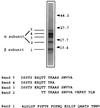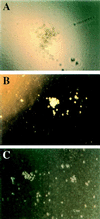cDNA cloning of FRIL, a lectin from Dolichos lablab, that preserves hematopoietic progenitors in suspension culture
- PMID: 9892687
- PMCID: PMC15190
- DOI: 10.1073/pnas.96.2.646
cDNA cloning of FRIL, a lectin from Dolichos lablab, that preserves hematopoietic progenitors in suspension culture
Abstract
Ex vivo culture of hematopoietic stem cells is limited by the inability of cytokines to maintain primitive cells without inducing proliferation, differentiation, and subsequent loss of repopulating capacity. We identified recently in extracts of kidney bean and hyacinth bean a mannose-binding lectin, called FRIL, and provide here evidence that this protein appears to satisfy properties of a stem cell preservation factor. FRIL was first identified based on its ability to stimulate NIH 3T3 cells transfected with Flt3, a tyrosine kinase receptor central to regulation of stem cells. Molecular characterization from polypeptide sequencing and identification of the cDNA of hyacinth bean FRIL shows 78% amino acid identity with a mannose-binding lectin of hyacinth beans. Treatment of primitive hematopoietic progenitors in suspension culture with purified hyacinth FRIL alone is able to preserve cells for 1 month without medium changes. In vitro progenitor assays for human hematopoietic cells cultured 3 weeks in FRIL displayed small blast-like colonies that were capable of serial replating and persisted even in the presence of cytokines known to induce differentiation. These results suggest that FRIL is capable of preserving primitive progenitors in suspension culture for prolonged periods. FRIL's clinical utility involving procedures for stem cell transplantation, tumor cell purging before autologous transplantation, and ex vivo cultures used for expansion and stem cell gene therapy currently are being explored.
Figures




Similar articles
-
Legume lectin FRIL preserves neural progenitor cells in suspension culture in vitro.Clin Dev Immunol. 2008;2008:531317. doi: 10.1155/2008/531317. Clin Dev Immunol. 2008. PMID: 18695740 Free PMC article.
-
The plant lectin FRIL supports prolonged in vitro maintenance of quiescent human cord blood CD34(+)CD38(-/low)/SCID repopulating stem cells.Exp Hematol. 2000 Jun;28(6):726-36. doi: 10.1016/s0301-472x(00)00163-6. Exp Hematol. 2000. PMID: 10880759
-
[The maintenance of cord blood CD34+ progenitor cells with plant lectin FRIL in vitro and the expression of related cell cycle modulator HTm4 and HTm4S].Sheng Li Xue Bao. 2004 Jun 25;56(3):306-12. Sheng Li Xue Bao. 2004. PMID: 15224142 Chinese.
-
[The mechanisms of a new plant lectin FRIL from dolichos lablab that preserves quiescent hematopoietic stem cells in suspension culture].Sheng Li Ke Xue Jin Zhan. 2003 Apr;34(2):127-31. Sheng Li Ke Xue Jin Zhan. 2003. PMID: 12889144 Review. Chinese.
-
Can human hematopoietic stem cells be cultured ex vivo?Stem Cells. 1994 Sep;12(5):466-76. doi: 10.1002/stem.5530120503. Stem Cells. 1994. PMID: 7528589 Review.
Cited by
-
Genomic Analysis of Storage Protein Deficiency in Genetically Related Lines of Common Bean (Phaseolus vulgaris).Front Plant Sci. 2016 Mar 31;7:389. doi: 10.3389/fpls.2016.00389. eCollection 2016. Front Plant Sci. 2016. PMID: 27066039 Free PMC article.
-
Crystallization and preliminary X-ray crystallographic analysis of a galactose-specific lectin from Dolichos lablab.Acta Crystallogr Sect F Struct Biol Cryst Commun. 2006 Feb 1;62(Pt 2):163-5. doi: 10.1107/S1744309106001448. Epub 2006 Jan 27. Acta Crystallogr Sect F Struct Biol Cryst Commun. 2006. PMID: 16511291 Free PMC article.
-
A Carbohydrate-Binding Protein from the Edible Lablab Beans Effectively Blocks the Infections of Influenza Viruses and SARS-CoV-2.Cell Rep. 2020 Aug 11;32(6):108016. doi: 10.1016/j.celrep.2020.108016. Epub 2020 Jul 24. Cell Rep. 2020. PMID: 32755598 Free PMC article.
-
Use of lectins in immunohematology.Asian J Transfus Sci. 2016 Jan-Jun;10(1):12-21. doi: 10.4103/0973-6247.172180. Asian J Transfus Sci. 2016. PMID: 27011665 Free PMC article. Review.
-
Legume lectin FRIL preserves neural progenitor cells in suspension culture in vitro.Clin Dev Immunol. 2008;2008:531317. doi: 10.1155/2008/531317. Clin Dev Immunol. 2008. PMID: 18695740 Free PMC article.
References
Publication types
MeSH terms
Substances
Associated data
- Actions
LinkOut - more resources
Full Text Sources
Other Literature Sources
Medical
Research Materials
Miscellaneous

